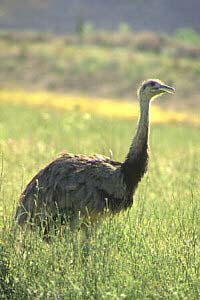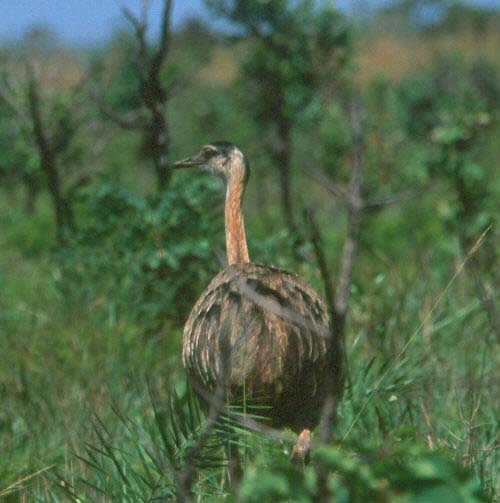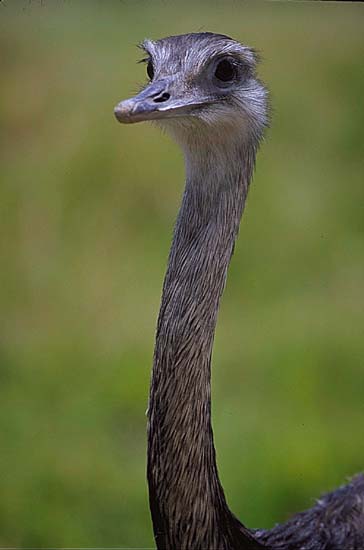Rhea americana (Greater Rhea)
 Adult female
Adult female
Description: Huge, flightless, three-toed terrestrial birds with long necks and legs. The overall colouer is very variable grey-brown. The thighs are feathered but the tarsi is totally bare.
The feathers are smooth and soft, this is due to their unique structure, the barbules lack the hooks that feathers normally have linking them together.
The males are slightly larger and darker than the females with a black ring at the base of the neck. The males have a penis, which is frequently visible.
Size: 127-140cm.
Weight: 20-25kg.
Senses: Rheas are good runners, they can reach speeds of 60 km/h. They are also surprisingly good swimmer and can even cross rivers.
They have excellent eyesight and good hearing, which alow them to detect their enemies a long way off.
Habitat: Typically found in pampas, campos, cerrado and open chaco woodland; normally in areas with at least some tall vegetation, tending to avoid open grassland. For breeding they stay close to a river, lake or marsh.
Range: Males guard territories during the breeding season, at other times of the yearthey tend to live in mixed grouos with females, males and juveniles. While males defend ranges alone, females live in small wandering groups.
Males often fight over their territory, entangling their necks and running in a circle around one another. The winner chases the loser and sometimes kicks or pecks at him.
 Adult male
Adult male
Distribution: South America.
Status: Not globally threatened. Has declined markedly and now considered near-threatened. Decline due partly to hunting for meat, partly to the collasal export of skins, with over 50,000 traded in 1980, most apparently originating from Paraguay, with Japan and USA leading consumers. In recent years, conservation of habitat for agriculture has become increasingly important in some areas, including strongholds in pampas and cerrado; in former, still common in protected areas and on some ranches, where often semi-captive; healthiest populations now in parts of Chaco region.
Daily Rhythm: They are basically diurnal, although it is thought that during very hot periods they may become active at night to feed and rest during the day to avoid sunstroke.
When sleeping they rest on their tarsi with the neck stretched out horizontally in front or folded back to one side in an s curve, sometimes they will lie flat on their bellies with the legs stretched out behind, but this is less common.
Voice: They most commonly make a deep resounding "bu-up" or "nan-du", which is most frequently uttered by males during the courtship display. Sometimes the same call is heard at night, presumably made by birds that have been disturbed. This sound can be heard at great distances and is more like a mammals roar than a birds call.
Outside the mating period they utter hoarse cries of alarm, snorts of anger and hissed threats. Young birds produce plaintive contact whistles, which helps to keep the group together and is most frequently used when danger threatens.
Enemies: Although they can easily outrun predators, they have a habit of retracing their steps when they are fleeing and then flopping down on the ground amongst the bushes and flatten their bodies against the ground. Due to the coloration of their plumage they can pass unnoticed as the predator passes right by. When they do run from their attacker they often zig-zag rapidly, they turn sharply at right angles and each time they must raise a wing to balance themselves, the neck is kept streached out horizontally to the front.
Prey: Omnivorous. Plant matter includes leaves (even of thistles), seeds, roots and fruits. Insects such as grasshoppers and flies and small vertebrates such as lizards, frogs, small birds and snakes make up the bulk of the animal matter.
Food and Feeding: When feeding they are almost continuosly moveing and will swallow pebbles to help break down their food. Flies are taken from around carrion.
When wadering in search of food they are known to associate with pampas deer, guanacos, vicunas, alpacas and where they are not persicuted by man, with sheep and cattle. The association with these other herbivores affords both species better protection against predators, rheas have exceelent sight and the mammalian herbivores have a great sense of smell.
Grouping: They generally live in mixed groups of males, females and juveniles, normally numbering 5-30 birds, although flocks of 50 and even more have been recorded.
While they are socaible birds the individual members within a group keep a certain distance from one another and any violation of this code can lead to a threat display. The bird that has been encroached on throws its head forwards with its bill open, at the same time they hiss prepeatedly. The head is then rapidly flung back, so that the neck adopts an S shape; such behaviour is also typical of sitting birds that are either incubating or just at rest.
Breeding: Generally August-Januaury, depending on the region. Males are simultaneously polygynous and females are serially polyandrous.
During the breeding season females separate off into small groups, while males become territorial. Apparently a small percentage of males, on reaching an advanced age, go off alone to become solitary.
At the start of the breeding season males begin to compete for territories in short fights. During these fights they circle one another and intertwine their necks walking round in circles together, some fights end with the males biting and kicking one another. The male that wins the contest chases the others from his territory and then tries to attract groups of females in. He does so by quickly rushing towards them with outspread wings. When he has managed to assemble between 2-12 females he begins to court them. In this display he zig-zags around the group of females, making the characteristic booming sound with his neck inflated abd his wings lifted up. Finally he stands beside one of the females with his neck slightly lowered in a u-shape and the feathers on his neck and head bristled up. Then he shakes his wings, before stretching them out to the sides, where he holds them motionless, so that the feathers quiver gracfully in the breeze.
After copulatio nthe male leads the female to the nest he has prepared previously. The females generally aproach the nest as a group and lay their eggs one after the other, when they have all layed they leave the nest site still in their group. In the following weeks they return every 2-3 days to leave some eggs.
Once the females have finnished laying into the nest they leave to mate with a nother male, then laying eggs in his nest; this process may be repeated several times during the three month mating season.
Gestation: Incubation lasts 35-40 days. This is performed by the male bird alone.
 Adult female
Adult female
Litter Size: Usually about 13-30 eggs per nest with up to 80 having been recorded and as little as 6, the eggs are layed by upto 12 different females.
Young Description: The eggs are golden yellow and soon d=fade to a dull white. The average size is 132 x 90 mm and 600 g.
The chicks are grey with dark stripes.
Juveniles are similar to adults in pluamge type.
Nest: The nest is a shallow depression, usually sheltered from vegetation, the male builds it alone.
Young Care: The male raises the young by himself. The male begins incubation 2-8 days after the eggs have been layed. During the incubation period he adopts a threatening attitude to anything that approaches. Hissing and snapping as he performs the display where his head is held out in front and his bill is held open, he hisses repeatedly, when incubating he stretches out his wings to cover the eggs also. At this stage he will threaten all who approach, including the females that have laid in the nest and wish to leave more eggs with the male. As a result of this behaviour some eggs are laid around the nest rather than in it. When the eggs are laid close enopugh he will roll them into the nest and incubate them. Some eggs are however left beyond the nest and left to rot, such eggs do not waste however, the rotting eggs attract large numbers of flies, these feed the male whilst he sits and the newly-hatched chicks have something to feed on.
When the first chicks begin to hatch they start to call, this is thought to stimulate the other chicks to break out of the shells too. The result is all the chicks hatching within a 24-28 hour period.
After a few days the chicks are led away from the nest by the male, and they keep together all the time using contact calls, this is essential, for they are easy prey once they are separated from their parent. In any dangerous situation the chicks crouch down on the ground or hide under the males wings, where they also take refuge from the sun when it is too hot and from the cold at night.
Males are jelous guardians of their young and even attack men on horse back on occasion. Lost chicks are always liable to be adopted by another male with his own young, this can lead to groups of chicks of varying ages.
Chicks remain with their parent for about 6 months, but the chicks, which are more half the size of an adult by now, generally remain in the group of youngsters until they are sexually mature.
The young are about half the size of their parent at 3 months of age.
Sexual Maturity: 2-3 years.
Longevity:
Geographical Variations:
Rhea americana americana
Distribution: North East to South East Brazil.
Rhea americana intermedia
Distribution: South East Brazil, Urugguay.
Rhea americana nobilis
Distribution: East Paraguay.
Rhea americana araneipes
Distribution: West Paraguay, East Bolivia, South West Brazil.
Rhea americana albescens
Distribution: North East Brazil and East Argentina.
Description: Albinos are fairly common amongst rheas and this subspecies has the highest rate.
Back to Main Page
Back to Birds